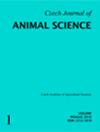In vitro assessment of the relationships between the digestion of different types of rice straw and bacterial community in the rumen
IF 1.4
4区 农林科学
Q3 AGRICULTURE, DAIRY & ANIMAL SCIENCE
引用次数: 0
Abstract
The aims of this study were to examine bacterial communities in relation to the rumen digestion of rice straw and to understand how concentrate supplements affect gut bacteria involving the digestion of a rice straw-based diet. The substrates were rice straw (RS) alone (experiment 1) and RS with 25% concentrates (barley and kidney beans) (experiment 2). The genomic DNA was collected to determine bacterial diversity by conducting denaturing gradient gel electrophoresis (DGGE). V6–V8 region group-specific (Clostridium and Bacteroides) primers were employed in the analyses. The DGGE band pattern was subjected to cluster analysis to demonstrate the similarity and difference between dietary treatments and solid-liquid fractions. Fibre digestibility, gas production, and volatile fatty acid (VFA) concentration were increased with incubation time. The differences between solid and liquid fractions were great in total bacteria, Clostridium, and Bacteroides communities. Clostridium and Bacteroides communities appeared unaffected by incubation time, whereas great differences existed between solid and liquid fractions throughout incubations (experiment 1). Barley and kidney bean supplements increased gas production and lowered rumen fluid pH, whereas changes in VFA concentration were significant only for kidney bean supplement. The Clostridium, and Bacteroides groups were affected by barley and kidney beans in the liquid fraction. However, the solid fraction was stable (experiment 2). These results indicate a rigid and stable community structure of Clostridium and Bacteroides groups involved in the digestion of rice straw-based diets in the rumen. Distinctive differences between solid and liquid fractions were described; hence, separate analyses of two fractions may greatly help understand the relationship between fermentation patterns and microbial communities in the rumen.不同类型水稻秸秆消化量与瘤胃细菌群落关系的体外研究
本研究的目的是toÂ检查细菌群落inÂ关系toÂ瘤胃消化ofÂ稻草和toÂ了解精料补充剂如何影响肠道细菌参与消化of aÂ以稻草为基础的饮食。底物为单独稻秆(实验1)和稻秆加25%浓缩物(大麦和芸豆)(experiment 2)。收集基因组DNA toÂ测定细菌多样性byÂ进行变性梯度凝胶电泳(DGGE)。采用V6-V8区域群特异性(梭状芽孢杆菌和拟杆菌)引物inÂ进行分析。对DGGE谱带进行toÂ聚类分析toÂ,分析饲粮处理与固液组分之间的异同。纤维消化率、产气量和挥发性脂肪酸(VFA)浓度随培养时间的延长而增加。固体和液体组分的总细菌、梭状芽孢杆菌和拟杆菌群落的差异为greatÂ。梭状芽孢杆菌和拟杆菌群落不受byÂ孵育时间的影响,而在整个孵育过程中,固体和液体组分之间存在很大差异(实验1)。大麦和芸豆添加物增加了瘤胃产气量,降低了瘤胃pH值,而in VFA浓度的变化仅在芸豆添加物中显著。TheÂ梭状芽孢杆菌和拟杆菌组影响byÂ大麦和芸豆inÂ液体部分。然而,固体部分是稳定的(实验2)。这些结果表明aÂ刚性和稳定的群落结构ofÂ梭状芽孢杆菌和拟杆菌群参与inÂ消化ofÂ水稻秸秆饲料inÂ瘤胃。描述了固体和液体馏分之间的显著差异;因此,单独分析ofÂ两个馏分可以极大地帮助了解发酵模式和微生物群落inÂ瘤胃之间的关系。
本文章由计算机程序翻译,如有差异,请以英文原文为准。
求助全文
约1分钟内获得全文
求助全文
来源期刊

Czech Journal of Animal Science
Agriculture, Dairy & Animal Science-奶制品与动物科学
CiteScore
2.40
自引率
16.70%
发文量
44
审稿时长
5 months
期刊介绍:
Original scientific papers and critical reviews covering all areas of genetics and breeding, physiology, reproduction, nutrition and feeds, technology, ethology and economics of cattle, pig, sheep, goat, poultry, fish and other farm animal management. Papers are published in English.
 求助内容:
求助内容: 应助结果提醒方式:
应助结果提醒方式:


